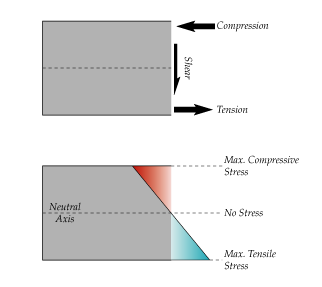Fuller (weapon)
|
|
For people named Fuller, see Fuller (disambiguation).
Some speculate that this design feature makes a weapon easier to withdraw after a stabbing attack by allowing air into the wound it produces, but in fact fullers have not been experimentally shown to have such an effect. Any suction effect or clenching of muscles which might trap objects in a body seems to affect similar blades equally regardless of the use of fullers. Many blades use fullers even when they are so short that the physical effect is negligible; in this case, the purpose may be to make the weapon resemble larger blades.
The basic design principle is that bending causes more stress in material near the edge or back of the blade than material in the middle, due to leverage. The diagram at left shows stress distribution in an ideal blade with a rectangular section, with only a small amount of shear stress present at the neutral axis. Fullers remove material from near this neutral axis, which is closer the blade's spine if only one edge is sharpened (see photo above). This yields stiffer blades of a given weight, or lighter blades of a given stiffness. The same principle is taken to an extreme in the I-shaped cross sections of most steel beams. Some even contend that this concept was borrowed into architecture from weapons design [1] (http://www.agrussell.com/knife_information/knife_encyclopedia/articles/blood_groove.html).In Japanese weaponmaking, fullers have a rich tradition and terminology. Katana fullers come in wide (bo-hi), twin narrow (futasuji-hi), twin wide and narrow (bo-hi ni tsure-hi), short (koshi-hi), twin short (gomabushi), twin long with joined tips (shobu-hi), twin long with irregular breaks (kuichigai-hi), and halberd-style (naginata-hi).
The Nepali kukri has a terminology of its own, including the "aunlo bal" (finger of strength/force/energy), a relatively deep and narrow fuller near the spine of the blade, which runs (at most) between the handle and the corner of the blade, and the "chirra", which may refer either to shallow fullers in the belly of the blade or a hollow grind of the edge, and of which two or three may be used on each side of the blade [2] (http://www.himalayan-imports.com/faq/Construction.html).
Reference
- "Blood groove", from the A. G. Russell knife encyclopedia (http://www.agrussell.com/knife_information/knife_encyclopedia/articles/blood_groove.html)
- Kukri terminology (http://www.himalayan-imports.com/faq/Construction.html)


